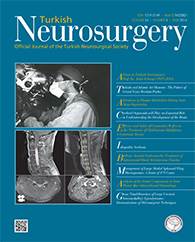MATERIAL and METHODS: Clinical records of 12 consecutive DAVFs patients (five women, seven men) treated with arterial balloon-assisted endovascular Onyx embolization were retrospectively collected to analysis their presenting symptoms, angiographic features, endovascular treatments, and clinical outcomes.
RESULTS: Six patients presented with cortical venous reflux (CVR). Nine patients underwent transarterial (TA) and 3 patients underwent transvenous (TV) embolization. The balloons were used in 3 types of approach: arterial protection in TA embolization, arterial flow reduction in TA embolization and arterial protection in TV approach. Angiograms demonstrated complete obliteration of the fistula in 11 patients and partial occlusion in one. One patient had Onyx embolization-related complication of transient hemi-facial hypoesthesia.
CONCLUSION: The Arterial balloon provides protection of intracranial artery and reduction of arterial flow in Onyx embolization of DAVF. This complementary method brought high cure rate.
Keywords : Dural arteriovenous fistula, Embolization, Balloon, Onyx




